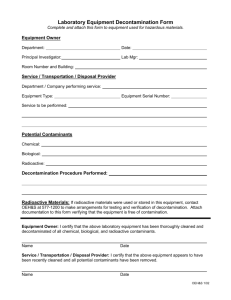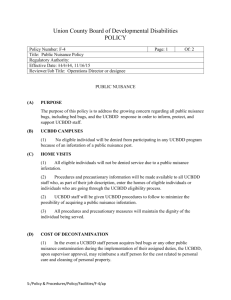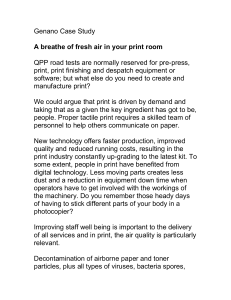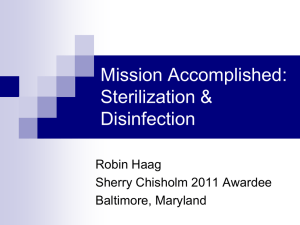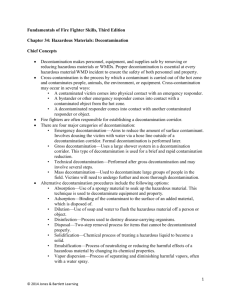Decontamination of Flexible Endoscopic Equipment Policy v2.Oct 14
advertisement
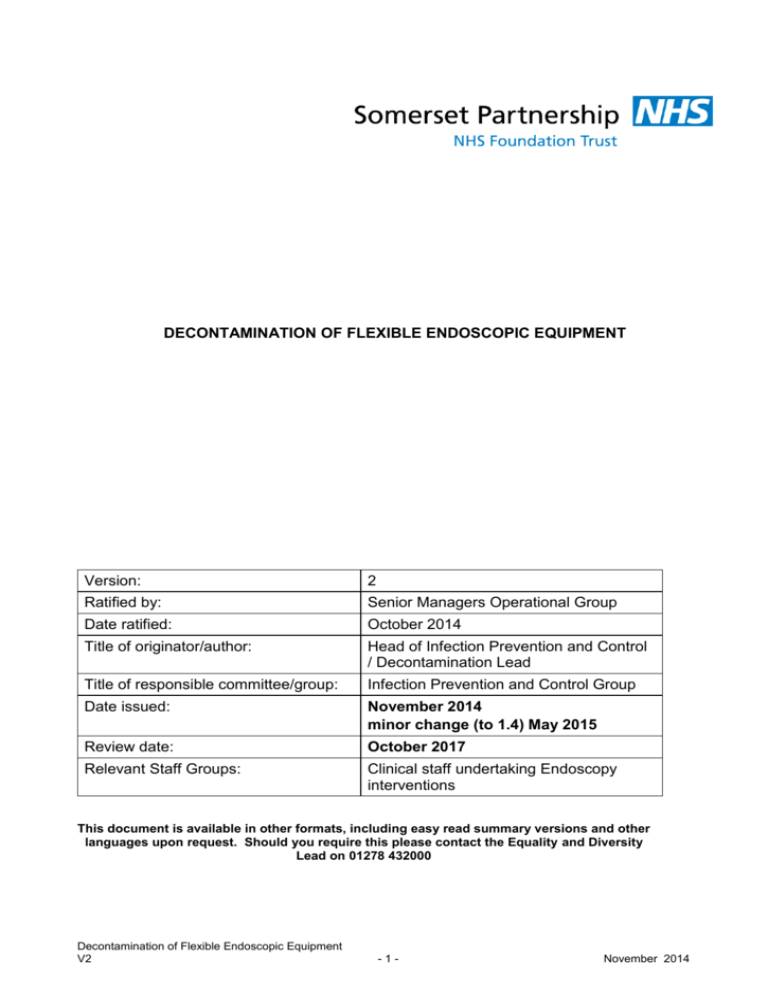
DECONTAMINATION OF FLEXIBLE ENDOSCOPIC EQUIPMENT Version: 2 Ratified by: Senior Managers Operational Group Date ratified: October 2014 Title of originator/author: Head of Infection Prevention and Control / Decontamination Lead Title of responsible committee/group: Infection Prevention and Control Group Date issued: November 2014 minor change (to 1.4) May 2015 Review date: October 2017 Relevant Staff Groups: Clinical staff undertaking Endoscopy interventions This document is available in other formats, including easy read summary versions and other languages upon request. Should you require this please contact the Equality and Diversity Lead on 01278 432000 Decontamination of Flexible Endoscopic Equipment V2 -1- November 2014 DOCUMENT CONTROL Reference KA/Oct14/DFEEP Version 2 Status FINAL Author Head if IPC / Decontamination Lead 1.5 – Amended following change of Decontamination responsibilities post move to new Bridgwater Community Hospital location Document objectives: To ensure that the Trust is able to provide assurance of compliance with robust endoscope decontamination methodology, thus ensuring patient safety. Intended recipients: All clinical staff involved in the delivery of the Endoscopy Service Committee/Group Consulted: Infection Prevention and Control/ Endoscopy User Group Amendments Monitoring arrangements and indicators: See relevant section Training/resource implications: See relevant section Approving body and date Clinical Governance Group Date: October 2014 Formal Impact Assessment Impact Part 1 Date: October 2014 Clinical Audit Standards NO Date: n/a Ratification Body and date Senior Managers Operational Group Date: October 2014 Date of issue November 2014 Review date October 2017 Contact for review Head of IPC/Decontamination Lead Lead Director Director of Infection Prevention and Control CONTRIBUTION LIST Key individuals involved in developing the document Name Designation or Group Tom Hall Trust Authorized Engineer (Decontamination) Lisa Stone / Michelle Barnham / Nicola Hall Group Members Infection Prevention and Control Team Infection Prevention and Control Implementation Group Medical Devices Group Michelle Crumb Head of Risk Tracy Griffin Theatre Sister, Minehead Community Hospital Clinical Policy Review Group Clinical Governance Senior Managers Operational Group Group Members Group Members Decontamination of Flexible Endoscopic Equipment V2 -2- November 2014 CONTENTS Section Summary of Section Doc Document Control 2 Cont Contents 3 1 Introduction 4 2 Purpose & Scope 4 3 Duties and Responsibilities 4 4 Explanations of Terms used 5 5 Flexible Endoscopy Service 5 6 Decontamination Principles 6 7 Training Requirements 11 8 Equality Impact Assessment 11 9 Monitoring Compliance and Effectiveness 11 10 Counter Fraud 11 11 Relevant Care Quality Commission (CQC) Registration Standards 11 12 References, Acknowledgements and Associated documents 12 Decontamination of Flexible Endoscopic Equipment V2 -3- Page November 2014 1. INTRODUCTION 1.1 Flexible endoscopes are complex re-usable instruments that require unique consideration with respect to decontamination and must be decontaminated following every endoscopic procedure. 1.2 Staff responsible for flexible endoscope decontamination must be trained for the role and records of training and competency assessment retained 1.3 There must be documented safe working practices for decontamination and periodic testing must be carried out as detailed in Health Technical Memorandum 2030 and the Choice Framework for local Policy and Procedures 01-06 – Decontamination of Flexible endoscopes: Policy and management (CFPP 01/06) 1.4 Flexible endoscopes are used within Trust managed Community Hospital sites as follows; Nasendoscopes at the following locations; Minehead Community Hospital; Bridgwater Community Hospital; Burnham on Sea Community Hospital; West Mendip Community Hospital; Chard Community Hospital; Shepton Mallet Community Hospital Cystoscopes are used at; Minehead Community Hospital Day Unit; Bridgwater Community Hospital Outpatient Department. 2. PURPOSE & SCOPE 2.1 In order to prevent the potential for transmission of infection at endoscopy each endoscope and device must be decontaminated with the same rigour following every endoscopic procedure. The guidance contained within HTM 2030, CFPP 01/06 and the Endoscope and Automated Endoscope Reprocessor (AER) manufacturer’s instructions should be followed. 2.2 This policy applies to all staff involved in the provision care of to patients undergoing an endoscopic procedure within Trust managed services. 3. DUTIES AND RESPONSIBLITIES 3.1 Director of Infection Prevention and Control - Executive staff member responsible for Trust Decontamination and ensuring decontamination processes used throughout the Trust are according to national standards. Reports risk to the Board. 3.2 Trust Decontamination Lead- Advises Director of Infection Prevention and Control as regards any shortfalls against National and European Directives or Guidance and Decontamination of Flexible Endoscopic Equipment V2 -4- November 2014 ensures that effective quality control and monitoring systems are in place for the decontaminated of reusable devices. 3.3 Day Case/Out Patient Department Unit Decontamination Lead - Day to day Management of Department and ensuring decontamination of flexible Endoscopes and associated items are maintained to required standards as stated in this policy. This post should also make sure all staff are trained to required standard. 3.4 Staff involved in endoscope decontamination – All staff involved in decontamination of flexible endoscopes are responsible for: Ensuring they have received training and assessed as competent to carry out the process; Ensuring they follow the decontamination process as outlined in this policy 3.5 Infection Prevention and Control Team - To support all named parties in this policy as regards infection prevention and control issues and give advice as required 4. EXPLANATIONS OF TERMS USED 4.1 AER: Automatic Endoscope Reprocessor. A machine that cleans and disinfects flexible endoscopes. A rinse followed by drying are the last stages of the machine cycle and uses bacteria free water and air, so the endoscope can be used directly on a patient. 4.2 Decontamination: A process which removes or destroys contamination so that infectious agents or other contaminants cannot reach a susceptible site in sufficient quantities to initiate infection or any other harmful response. 4.3 Flexible Endoscope: A flexible Instrument with a fibreoptic camera which is passed into an area of the body (e.g. the bladder) which allows a greatly magnified image to be projected onto a screen. 4.4 Nasendoscope: A flexible endoscope used to explore the nasal passages, larynx, and oropharynx. 4.5 Cystoscope: A flexible endoscope used to explore the urinary tract and bladder. 4.6 Creutzfeldt-Jakob Disease (Cjd) And Variant Creutzfeldt-Jakob Disease (Vcjd) Transmissible spongiform encephalopathies (TSEs) are a group of diseases which affect both humans and animals. 5. FLEXIBLE ENDOSCOPY SERVICE 5.1 An Endoscopy service is delivered via Bridgwater and Minehead Community Hospitals. 5.2 The Minehead based service is delivered via the Hospital Day Surgery Unit, and is managed via a locally appointed lead, who has received appropriate training to manage the decontamination facilities within this location. Whilst the decontamination equipment is owned and managed by the Trust, the activity generated is owned and managed via Taunton and Somerset NHS Foundation Decontamination of Flexible Endoscopic Equipment V2 -5- November 2014 Trust. The decontamination equipment in this location is the Getinge (Lancer) ED Flow AER 5.3 The Bridgwater Community Hospital based service is delivered via the Outpatient Department. The activity generated within this site is owned by Taunton and Somerset NHS Foundation Trust. The AER in this location is based within the Taunton and Somerset NHS Foundation Trust managed Endoscopy suite, which is attached to Bridgwater Community Hospital, but managed via Taunton and Somerset NHS Foundation Trust staff. 5.3.1 The process for decontamination of endoscopes between patients has been agreed between Taunton and Somerset NHS Foundation Trust and Somerset Clinical Commissioning Group. The agreed process will involve the use of a ‘sheathed’ cover for the endoscope, with the endoscope being manually decontaminated between patients via the use of the Tristal 3 wipe system. Training for this process is provided via Taunton and Somerset NHS Foundation Trust. The equipment is finally decontaminated via the Taunton and Somerset managed AER. 5.4 Water testing and validation for Trust owned equipment is routinely undertaken by an externally contracted company (Medipure). 5.5 Nasendoscopes are undertaken in a proportion of the community hospital settings (see section 1.4) and manual cleaning is utilised for the decontamination of this equipment. All staff in these locations are required to receive training to ensure full compliance with the decontamination process. 6. DECONTAMINATION PRINCIPLES 6.1 General Decontamination Principles For Flexible Endoscopes • Decontamination of endoscopes should begin as soon as possible after use. • Flexible endoscopes entering sterile body cavities must have undergone a sterilisation process • It is important that staff are familiar with the equipment they are responsible for re- processing, testing and maintaining. • Standard infection prevention and control precautions apply and appropriate personal protective equipment must be readily available and should be used to protect the healthcare worker, engineer and Test Person from exposure to biological agents and toxic chemicals. • All staff responsible for flexible endoscope decontamination must have been trained for the role. • A record should be kept of all training given and levels of competencies achieved. • Safe working practices in the decontamination area should be written down and understood by all staff. . Decontamination of Flexible Endoscopic Equipment V2 -6- November 2014 • It is important that the chemicals used by the AER have been recommended by the AER manufacturer and validated. The AER should be set-up for stage times and temperature to suit the chemicals used. • Manual cleaning alone is not acceptable and an AER automatic endoscopy reprocessor (AER) must be used in a dedicated area with up-to-date maintenance and testing records. • Decontamination of endoscopes must be undertaken between patients, at the beginning and end of each list by staff trained for the purpose. The department protocol should be followed. • Flexible Endoscopes should be decontaminated if not used within 3 hours after initial decontamination. Scopes stored in a validated drying cabinet can be used straight from the cabinet, providing the storage period does not exceeded the maximum time detailed in the manufacturer’s instructions. • Before the start of a list, each endoscope to be used should be decontaminated through an AER cycle unless stored in a validated drying cabinet for a period not exceeding the recommended storage time. • Manufacturer’s instructions should be followed for regular self-disinfection of AERs and water filters, if required. A log should be kept of these processes. AER self-disinfection should take place at least at the start of each working day. • Thorough manual cleaning with a low foaming warm enzymatic detergent must be undertaken before automatic endoscope decontamination. This procedure includes brushing and flushing of all accessible endoscope channels, buttons and re-useable accessories. • Detergents and disinfectants should be used at the correct temperature and concentration in accordance with the manufacturer’s instructions. • Users should ensure the correct AER adaptors are available for all endoscopes to be used; this will ensure irrigation of all channels. • Where possible single-use items should be used. Any equipment that is steam sterilized should be logged. • Water used in the AER should be free of particulate contamination and microorganisms. Samples of the final rinse water from the AER should be sent weekly to the microbiology laboratory for total viable count. • The local designated lead is responsible for ensuring weekly microbiological test results are recorded and presented on a graph to determine a trend of data. If the counts show a significant rise i.e. above 10 cfu/100ml, or the presence of Pseudomonas sp. is detected the AER will be taken out of use and advice sought from Decontamination Lead. • A record should be kept of the serial number of each endoscope and valves (including loan endoscopes) and each re-useable accessory used in each Decontamination of Flexible Endoscopic Equipment V2 -7- November 2014 patient. This is important for any future contact tracing when possible endoscopic transmission of disease is being investigated. • It is essential that all decontamination stages are included after every use of the endoscope and that none are omitted. All channels must be flushed, even if they were not used during the preceding patient procedure. • A weekly check should be carried out to determine correct operation of the AER cleaning stage. Failure of this test should be investigated and may involve assistance of the Test Person or Maintenance Person. • A regular check of the AER logbook is required to make sure periodic testing is carried out according to HTM 2030 and the results are satisfactory. In addition the execution of regular maintenance tasks should be confirmed. • Endoscopy should be avoided wherever possible in patients with suspected or confirmed CJD. A dedicated endoscope should be used and fully cleaned and decontaminated alone in the AER after use. The scope should then be quarantined and may be reused exclusively on the same individual patient if required. For further details see CJD policy. • Endoscopes should be stored in a validated drying cabinet for a period not exceeding the time detailed in the manufacturers’ instructions. Storage in this manner allows endoscopes to be used directly from the cabinet. If this facility is not available hang endoscopes vertically in a designated dry and wellventilated storage cupboard. These endoscopes will require to be decontaminated before use. • All detachable components should have been previously removed and should not be replaced until the endoscope is next used. It is important that re-useable valves stay with the associated endoscope to allow traceability records to be kept. MONITORING Daily duties • Automatic control test or check AER printout for correct operation; • Remove and clean strainers; Weekly Tests; • Check final rinse water quality, if soft water check hardness, if RO water check conductivity (Undertaken by Trust user); • Sample final rinse water for total viable count (undertaken by Trust identified contractor); • Carry out cleaning efficacy test as described in the department protocol (undertaken by local department). Decontamination of Flexible Endoscopic Equipment V2 -8- November 2014 Quarterly Tests • Check the quarterly tests have been carried out by the Test Person and the results are satisfactory. Listed in HTM 2030 validation & Verification section. These are undertaken by external contractors Annual Tests • Check the annual tests have been carried out by the Test Person and the results are satisfactory. Listed in HTM2030 validation & Verification section. Undertaken by external contractors. Monitoring – Flexible Endoscopes: For each endoscope before use in a clinic; • Check the integrity of the insertion tube and the distal end, also check the buttons for damage or poor seals; • Check the entire endoscope as described in the manufacturer’s instructions. Endoscope rinse water • Before the start of a clinic open a fresh sterile water bottle and check the supply of new syringes ready for use. Monitoring – connectors • Check all connectors to be used are in good conditions and the ends fit correctly to the endoscopes to be used and the AER outlets. Monitoring – drying cabinets • Where used, on a regular basis e.g. weekly, measure the differential pressure across the HEPA filter to determine if the filter has a leak. Keep a daily record of the pressure inside the cabinet to determine if the filter and pump are operating correctly. • Quarterly check the air quality of the cabinet using a bacteria air counter or particle counter, undertaken by external contractors. Evaluation • Each quarter the test data for each AER and flexible endoscope record should be examined to determine satisfactory operation. Undertaken by Department Lead and external AED (Authorised Engineer decontamination); • The log book of each AER should be inspected and any non-conformities be investigated and reviewed at the Trust (quarterly) Endoscopy Working Group where an action report will be produced to rectify any issues with progress also monitored via this group and Infection Prevention and Control; • An audit of flexible endoscope decontamination will be carried out annually by the Department Lead to check that all procedures are being followed and the Decontamination of Flexible Endoscopic Equipment V2 -9- November 2014 flexible endoscopes are in good state of repair. A report highlighting any nonconformity will be sent to the Endoscopy Working Group for further investigation and an action plan developed to rectify any issues. Progress against these action plans will be monitored via the Endoscopy Working Group and also the Trust Infection Prevention and Control Group. 6.2 General Decontamination Principles For Nasendoscopes A scientifically validated product must be used when manual decontamination is being undertaken. The approved product is the Tristel Sporicidal Wipes System which incorporates a Pre-clean wipe Sporicidal wipe Rinse wipe Audit/traceability trail Do NOT use if the wipe sachet or foam bottle has been damaged. 1) Use Tristel pre-clean wipe to decontaminate the instrument, open sachet to activate foam of the enzymatic, proceed to wipe over instrument including cord for 20 seconds. 2) Second step in decontamination process is to put on clean gloves and apron. Using Tristel Sporicidal Wipe sachet pump 4 measures of “activator foam” onto sporicidal wipe, scrunch to mix active ingredients, wait 15 seconds, wipe the surface of the instrument ensuring all areas have come in contact with the solution, all areas of the surface must come into contact with the wipe at least once. Wait 30 seconds. 3) Third step open Tristel Rinse Wipe sachet and wipe over instrument, place the cleaned instrument onto a clean paper towel. The Rinse wipe is utilised to remove and neutralise chemical residues from the surface. 4) Dispose of paper roll into clinical waste bag. 5) Remove and dispose of gloves into clinical waste bag. 6) Wash and dry hands. 7) Complete audit book (for traceability), remove both labels from the book of the sporicidal wipe, place one label in the patients chart and one label in the audit book. 8) Repeat above process between each patient and at the end of the clinic decontaminated equipment should be returned to storage area. Decontamination of Flexible Endoscopic Equipment V2 - 10 - November 2014 Precautions and Considerations The cleaning and disinfection of Nasendoscopes requires a high-level disinfection process. Cleaning of Nasendoscopes is to be performed between each patient examination 7. TRAINING REQUIREMENTS 7.1 Staff undertaking AER decontamination processes are required to be trained as per the requirements of HTM 2030, CFPP 01/06. 7.2 The Trust will work towards all staff being appropriately trained. 8. EQUALITY IMPACT ASSESSMENT All relevant persons are required to comply with this document and must demonstrate sensitivity and competence in relation to the nine protected characteristics as defined by the Equality Act 2010. In addition, the Trust has identified Learning Disabilities as an additional tenth protected characteristic. If you, or any other groups, believe you are disadvantaged by anything contained in this document please contact the Equality and Diversity Lead who will then actively respond to the enquiry. 9. MONITORING COMPLIANCE AND EFFECTIVENESS 9.1 The policy will be monitored via Trust Endoscopy Working Group and the Infection Prevention and Control Group. Quarterly Infection Prevention and Control Reports include Endoscopy related information and are submitted to the Trust Clinical Governance Group who report directly to the Trust Board. 9.2 Monitoring the operation of each AER requires periodic tests to be carried out as detailed in HTM 2030/ CFPP 01/06 and managed locally by the designated Lead. Please see Appendix B for further details. 10. COUNTER FRAUD 10.1 The Trust is committed to the NHS Protect Counter Fraud Policy – to reduce fraud in the NHS to a minimum, keep it at that level and put funds stolen by fraud back into patient care. Therefore, consideration has been given to the inclusion of guidance with regard to the potential for fraud and corruption to occur and what action should be taken in such circumstances during the development of this procedural document. 11. RELEVANT CARE QUALITY COMMISSION (CQC) REGISTRATION STANDARDS The standards and outcomes which inform this procedural document are as follows: Section Outcome Information and involvement 2 Consent to care and treatment Personalised care, treatment and support 4 Care and welfare of people who use services Safeguarding and safety 6 8 Decontamination of Flexible Endoscopic Equipment V2 - 11 - Cooperating with other providers Cleanliness and infection control November 2014 Quality and management 12. 16 Assessing and monitoring the quality of service provision REFERENCES, ACKNOWLEDGEMENTS AND ASSOCIATED DOCUMENTS References Department of Health publications (England only): Choice Framework for local Policy and Procedures 01-06 – Decontamination of flexible endoscopes: Operational management manual 13536:1.0. Medical Device Alert Ref: MDA/2012/037 Issued: 28 June 2012 at 14:00; Reusable Transoesophageal Echocardiography, Transvaginal and Transrectal Ultrasound Probes (Transducers). All Models. All Manufacturers Musgrove Park Hospital, Taunton and Somerset NHS Foundation Trust Decontamination of Flexible Endoscope Equipment Policy The Health and Safety at Work Act and associated Regulations The Control of Substances Hazardous to Health Regulations EU Council Directive 93/42 EEC concerning Medical Devices EU Council Directive 99/44 EEC concerning product liability Health Technical Memorandum 01-01 Decontamination of reusable medical devices Health Technical Memorandum 2010: Sterilisation Health Technical Memorandum 2030: Washer disinfectors http://www.mhra.gov.uk/Publications/Safetyguidance/DeviceBulletins/CON0073 Steam sterilizers http://www.mhra.gov.uk/Publications/Safetyguidance/DeviceBulletins/CON0073 Decontamination of endoscope http://www.mhra.gov.uk/Publications/Safetyguidance/DeviceBulletins/CON2025 Cross reference to other procedural documents Cleaning of equipment and decontamination policy (to be read in conjunction with the medical devices policy) Creutzfeldt-Jakob disease (CJD) policy Development & Management of Organisation-wide Procedural Documents Policy and Guidance Hand Hygiene Policy Infection Control Surveillance Policy Infection control: standard infection control precautions policy (incorporating blood and body fluid spillage) Policy Learning Development and Mandatory Training Policy Decontamination of Flexible Endoscopic Equipment V2 - 12 - November 2014 Risk Management Policy and Procedure Staff Mandatory Training Matrix (Training Needs Analysis) Training Prospectus Untoward Event Reporting Policy and procedure All current policies and procedures are accessible in the policy section of the public website (on the home page, click on ‘Policies and Procedures’). Trust Guidance is accessible to staff on the Trust Intranet. Decontamination of Flexible Endoscopic Equipment V2 - 13 - November 2014

